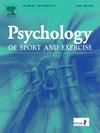Embodied decision making in athletes and other animals
IF 3.3
2区 心理学
Q2 HOSPITALITY, LEISURE, SPORT & TOURISM
引用次数: 0
Abstract
Humans and other animals continuously make embodied decisions about ongoing or pending courses of action. Examples of embodied decisions include a hunting lioness's decision of which gazelle to chase and a soccer player's decision of which teammate to pass the ball to. The study of embodied decisions has recently gained tractions across several fields, including cognitive psychology, neuroscience, and sports science. Here, we summarize key insights from these studies and highlight that they imply a shift of perspective from viewing decision-making as a central cognitive process largely separated from perception and action dynamics to a more integrative perspective that recognizes its embodied and situated nature. We discuss how embodied decisions can be effectively conceptualized in terms of the parallel specification and selection between available (and future) affordances, i.e., as an “affordance competition” process. We discuss studies addressing various aspects of embodied decisions, which include the selection between courses of action, the involvement of motor processes in perceptual and cognitive tasks, motivational factors and the decision of how vigorously and urgently to act. Furthermore, we highlight current controversies in the field and open directions for future work – and their implications for the advancement of our understanding of the mind and the behavior of athletes.
运动员和其他动物的具身决策。
人类和其他动物不断地对正在进行或悬而未决的行动过程做出具体化的决定。具体决策的例子包括一只狩猎的母狮决定追赶哪只瞪羚,一个足球运动员决定把球传给哪位队友。具体化决策的研究最近在几个领域获得了关注,包括认知心理学、神经科学和运动科学。在这里,我们总结了这些研究的关键见解,并强调它们意味着将决策视为一个主要与感知和行动动力学分离的中心认知过程的观点转变为一个更综合的观点,即认识到其具体化和情境性。我们讨论了具体化的决策如何在并行规范和可用(和未来)功能之间的选择方面有效地概念化,即作为“功能竞争”过程。我们讨论了具体决策的各个方面的研究,包括行动方案之间的选择,知觉和认知任务中运动过程的参与,动机因素以及如何积极和紧急地采取行动的决定。此外,我们强调了当前在该领域的争议和未来工作的开放方向-以及它们对我们对运动员思想和行为的理解的进步的影响。
本文章由计算机程序翻译,如有差异,请以英文原文为准。
求助全文
约1分钟内获得全文
求助全文
来源期刊
CiteScore
6.40
自引率
5.90%
发文量
172
审稿时长
69 days
期刊介绍:
Psychology of Sport and Exercise is an international forum for scholarly reports in the psychology of sport and exercise, broadly defined. The journal is open to the use of diverse methodological approaches. Manuscripts that will be considered for publication will present results from high quality empirical research, systematic reviews, meta-analyses, commentaries concerning already published PSE papers or topics of general interest for PSE readers, protocol papers for trials, and reports of professional practice (which will need to demonstrate academic rigour and go beyond mere description). The CONSORT guidelines consort-statement need to be followed for protocol papers for trials; authors should present a flow diagramme and attach with their cover letter the CONSORT checklist. For meta-analysis, the PRISMA prisma-statement guidelines should be followed; authors should present a flow diagramme and attach with their cover letter the PRISMA checklist. For systematic reviews it is recommended that the PRISMA guidelines are followed, although it is not compulsory. Authors interested in submitting replications of published studies need to contact the Editors-in-Chief before they start their replication. We are not interested in manuscripts that aim to test the psychometric properties of an existing scale from English to another language, unless new validation methods are used which address previously unanswered research questions.

 求助内容:
求助内容: 应助结果提醒方式:
应助结果提醒方式:


